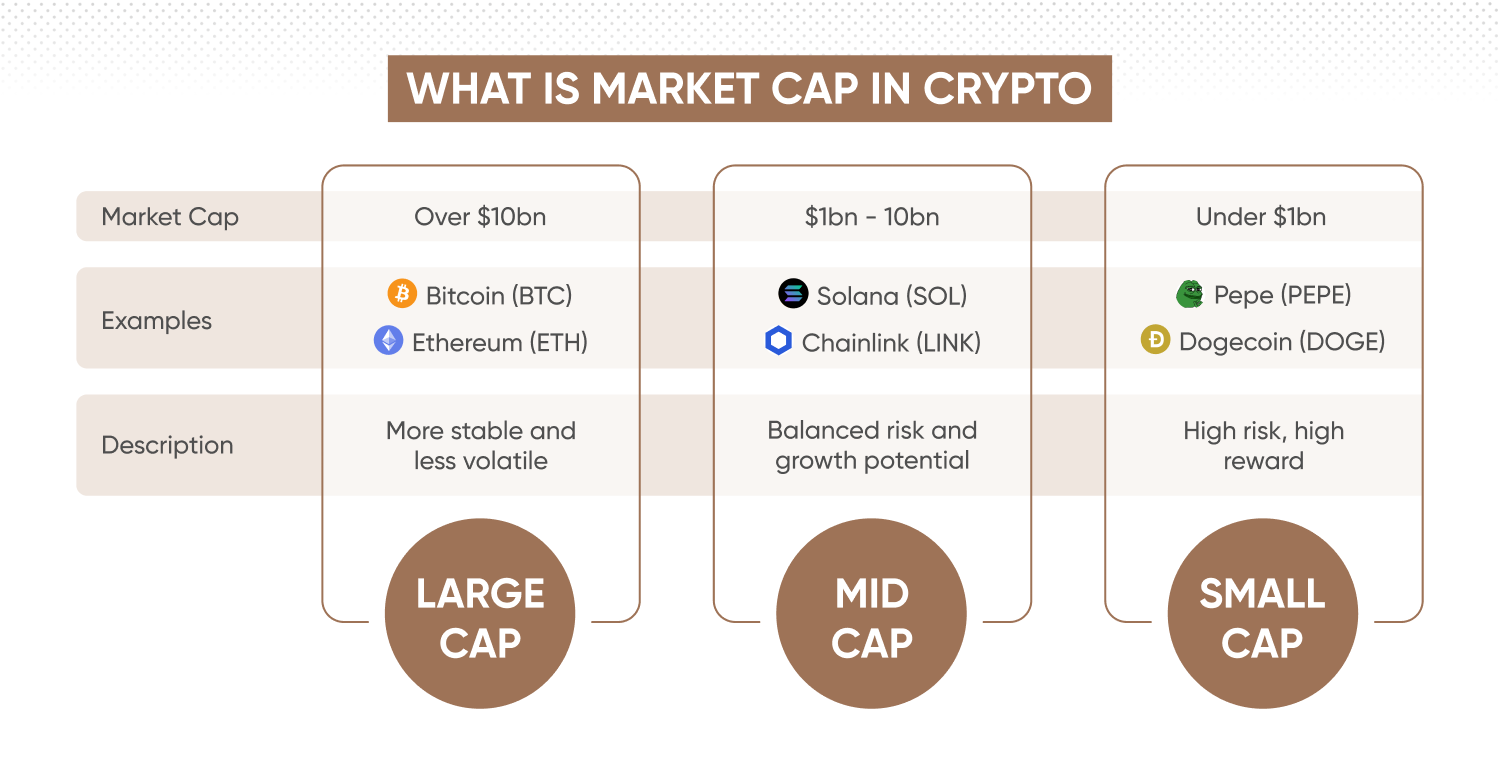What is crypto market cap and how does it work?

Did you know that by the end of June 2025, the global crypto market cap had reached a whopping $3.33tn? Of this, bitcoin accounted for the lion’s share, with a total crypto market cap of $2.15tn. But what is crypto market cap? Understanding this is crucial for making informed trading decisions, as it offers a snapshot of a digital currency’s relative size, stability and potential.
Key takeaways
-
Crypto market cap equals current price times circulating supply, with global market reaching $3.33tn by June 2025, Bitcoin accounting for $2.15tn.
-
Cryptocurrencies are classified as large-cap over $10bn, mid-cap $1bn-$10bn, or small-cap below $1bn, with size inversely correlated to volatility.
-
Market cap enables size comparison and risk assessment, as larger caps indicate established projects with higher liquidity and greater resistance to manipulation.
-
Market cap can mislead due to supply manipulation and doesn't reflect actual liquidity or demand, making trading volume and order book depth equally important.
-
Effective portfolio diversification combines stable large-cap cryptos with growth-oriented smaller caps, though higher market cap doesn't guarantee success or widespread adoption.
What is crypto market cap?
In the stock market, market cap is calculated by multiplying a company’s share price by the total number of outstanding shares. Similarly, in the crypto world, total crypto market cap is determined by multiplying the current price by the circulating supply of the coin. This figure gives you an idea of the relative scale of different digital assets, from giants like bitcoin to emerging altcoins like pepe.
Global crypto market cap refers to the total market capitalisation of all cryptocurrencies combined, providing the size of the entire crypto economy.
How does crypto market cap work?
To know what the total crypto market cap is, you need to know how to calculate it. The formula is:
Here:
Current price per coin is the present trading price of one unit of the cryptocurrency.
Circulating supply refers to the number of coins that are publicly available and actively traded in the market.
Based on their market cap, cryptos are typically categorised into three main classifications:
Large cap: these are the established behemoths, generally boasting a market cap of $10bn or more, such as bitcoin (BTC) and ether (ETH). They are often considered more stable and less volatile due to their significant market presence, widespread adoption and deeper liquidity.
Mid cap: with a market cap range of about $1bn to $10bn, these cryptocurrencies represent a diverse group. They often include projects with solid fundamentals, developing ecosystems and growing communities. While potentially offering higher growth potential than large caps, they also carry a greater risk due to higher volatility.
Small cap: these are generally newer or less established projects with a market cap below $1bn. Small-cap cryptos can offer explosive growth potential if their underlying projects succeed. However, they also tend to be the most volatile.

Learn more about trading cryptocurrencies with Capital.com’s guide to trading crypto..
What’s included in the crypto market cap?
When understanding what crypto market cap is, it’s important to distinguish between circulating supply and total supply. Circulating supply is the number of coins currently available and traded on the market. This is the figure used to calculate the market cap. In contrast, total supply refers to the total number of coins that have been mined or are in existence, including those locked, reserved or not yet released. For example, bitcoin’s circulating supply at the end of June 2025 stood at 19.89m BTC while its total supply is capped at 21m coins.
Another useful metric is the fully diluted market cap, calculated as:
The fully diluted market cap offers a long-term perspective on a crypto’s potential future valuation. A significant difference between the current and fully diluted market cap can indicate future inflation or dilution if a large portion of the total supply is yet to enter circulation. This is especially important for investors considering the long-term viability of a project.
Benefits and drawbacks of crypto market cap
While a powerful tool for traders, market cap in crypto has both advantages and limitations. A major benefit is that it helps compare the relative size of cryptocurrencies. Market cap provides a quick and easy way to gauge a coin’s scale compared to others. A higher market cap generally suggests a more established and resilient project.
Market cap also acts as a useful risk indicator. Cryptos with larger total market caps are often perceived as less risky due to their higher liquidity and greater resistance to price manipulation. Conversely, smaller market cap projects might have high reward potential but come with increased risk and volatility.
A drawback of using this metric is that it can be misleading due to supply manipulation. The circulating supply figure can sometimes be manipulated or misrepresented, leading to an artificially inflated market cap. Illiquid coins held by founders or early investors might be counted as circulating, skewing the true market picture.
Also, market cap doesn’t account for liquidity and real market demand. A high market cap doesn’t always translate to high liquidity or genuine demand.
It’s essential to look beyond just the market cap and consider trading volume and order book depth.
Learn more about trading cryptos other than bitcoin. Check out Capital.com’s altcoin trading guide.
How to use market cap in crypto trading?
Total crypto market cap can be used to evaluate the viability of a digital currency for portfolio diversification. A mix of large-cap cryptocurrencies can offer stability while mid-to-small-cap coins can be included for their growth potential. Market cap also helps in risk assessment. If you have a lower risk tolerance, you might prefer higher market cap cryptos.
Some traders look for undervalued mid-cap or small-cap projects with strong fundamentals and growth potential. Knowing how to calculate crypto market cap can help in choosing such altcoins.
Common misconceptions about crypto market cap
It’s best to strengthen your knowledge before trading. For instance, some traders believe higher market cap equals better. This is not always true. While often indicative of stability, a high market cap doesn’t guarantee future success or make a project immune to failure.
Another misconception is that market cap reflects adoption. While related, market cap reflects price and supply, rather than the actual use or adoption of a cryptocurrency.
For those interested in exploring different trading approaches, consider learning about CFD trading and how crypto trading differs from investing.
Examples of market cap impact
Historical price moves illustrate the impact of global and individual crypto market caps on investor sentiment. For instance, bitcoin’s consistently high market cap has solidified its position as the ‘digital gold’ and benchmark for the entire crypto market. Significant movements in BTC’s market cap often trigger ripple effects across altcoins.
There are also numerous instances where small-cap altcoins experience meteoric rises in market cap due to speculative frenzy, only to crash dramatically when the hype subsides. For example, doge surged 12.9% after 21Shares filed for a spot doge ETF in May 2025, only to plunge soon afterwards. Dogecoin shed 47.69% between January to June 2025.
These events highlight the importance of risk management.
Ready to explore the world of crypto? Create an account with Capital.com, an award-winning broker.
You can also explore the market caps of large companies and collections of the biggest companies in different industries:
- SAP market capitalization
- Sony market capitalization
- Nike market capitalization
- Nvidia market capitalization
- Reddit market capitalization
- Blackrock market capitalization
- ASML market capitalization
- Largest companies by market capitalization
- Largest tech companies by market capitalization
- Largest AI companies by market capitalization
FAQs
What is market cap in crypto?
Market cap in crypto refers to the total value of a cryptocurrency, calculated by multiplying its current price by the number of coins in circulation.
How do you calculate crypto market cap?
You can calculate crypto market cap by using the following formula:
Crypto Market Cap = Current Price per Coin × Circulating Supply of Coins
Is market cap the best indicator for crypto trading?
Market cap is a crucial indicator for crypto trading, but not the only one. It should be used in conjunction with other metrics like trading volume, project fundamentals, team and technology.
Can crypto market cap change overnight?
Yes, due to the potential high volatility, crypto market cap can fluctuate significantly, leading to substantial changes resulting from price moves.
Why do some cryptocurrencies have a high market cap but low value?
This often occurs when a cryptocurrency has a very large circulating supply. For example, a coin priced at $0.001 with a supply of 10bn coins would have a market cap of $10m.